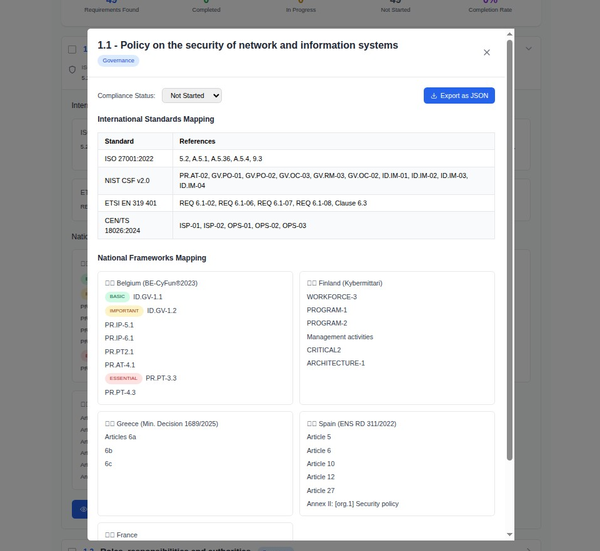Case Study: The Global Landscape of AI Laws and Regulations in 2024

As artificial intelligence (AI) technology continues to evolve, governments worldwide are increasingly focusing on establishing regulations to ensure its ethical use, transparency, and security. This case study examines the adoption and implementation of AI laws and regulations across different regions in 2024, highlighting key legislation, their impacts, and the challenges faced.

European Union: The AI Act
Overview:
The European Union (EU) has been at the forefront of AI regulation with the introduction of the AI Act. Proposed in 2021 and adopted in 2024, the AI Act aims to create a comprehensive regulatory framework to ensure that AI systems used in the EU are safe, transparent, and respect fundamental rights.
Key Provisions:
- Risk-Based Classification: AI systems are classified into four risk categories: unacceptable risk, high risk, limited risk, and minimal risk. Each category has specific regulatory requirements.
- Prohibited Practices: AI systems deemed to pose an unacceptable risk, such as social scoring by governments, are banned.
- Requirements for High-Risk AI: High-risk AI systems must comply with stringent requirements, including data governance, transparency, and human oversight.
- Transparency Obligations: Providers of AI systems must ensure transparency, allowing users to understand how AI decisions are made.
Impact:
- Compliance Costs: Companies deploying AI systems in the EU face increased compliance costs to meet the regulatory requirements.
- Innovation Incentives: The regulation encourages innovation in safe and ethical AI, potentially leading to the development of new, compliant AI technologies.
Sources:
United States: Algorithmic Accountability Act
Overview:
In the United States, the Algorithmic Accountability Act was reintroduced in 2023 and came into effect in 2024. This legislation requires companies to conduct impact assessments for AI systems that significantly affect consumers' lives.
Key Provisions:
- Impact Assessments: Companies must perform regular impact assessments to evaluate the potential biases, privacy risks, and security concerns of their AI systems.
- Transparency Reports: Firms are required to submit transparency reports detailing their AI systems' operation, data sources, and potential impacts on consumers.
- Regulatory Oversight: The Federal Trade Commission (FTC) is empowered to enforce compliance and penalize companies that fail to adhere to the regulations.
Impact:
- Increased Accountability: Companies are held accountable for the ethical and fair use of AI, promoting consumer trust.
- Operational Adjustments: Businesses need to invest in internal processes and tools to conduct comprehensive AI impact assessments.
Sources:
China: New Generation AI Development Plan
Overview:
China continues to expand its regulatory framework for AI through its New Generation AI Development Plan, updated in 2024. This plan emphasizes both the promotion of AI innovation and the need for regulatory measures to address ethical and security concerns.
Key Provisions:
- Ethical Standards: Establishes ethical guidelines for AI development and deployment, focusing on fairness, transparency, and accountability.
- Data Security: Strengthens regulations around data security and privacy in AI applications, particularly in critical sectors such as healthcare and finance.
- Innovation Support: Provides incentives and support for AI research and development, aiming to position China as a global leader in AI.
Impact:
- Balancing Act: The plan aims to balance innovation with ethical considerations, fostering a robust AI ecosystem while addressing public concerns.
- Global Influence: China’s regulatory approach may influence other countries’ AI policies, especially in regions with strong trade relations with China.
Sources:
Japan: AI Utilization and Implementation Guidelines
Overview:
Japan has adopted a more collaborative approach to AI regulation with the introduction of the AI Utilization and Implementation Guidelines in 2024. These guidelines are designed to promote responsible AI use while encouraging innovation.
Key Provisions:
- Guiding Principles: Establishes guiding principles for AI use, including respect for human rights, fairness, and accountability.
- Public-Private Collaboration: Encourages collaboration between government, industry, and academia to develop and implement AI technologies.
- Sector-Specific Guidelines: Provides specific guidelines for AI applications in sectors such as healthcare, finance, and transportation.
Impact:
- Industry Engagement: The collaborative approach fosters industry engagement and compliance, ensuring that AI systems are developed responsibly.
- Global Leadership: Japan aims to lead in the ethical use of AI, setting standards that may influence global AI governance.
Sources:
Global Trends and Challenges
Adoption Rates:
- Varied Adoption: The adoption of AI regulations varies widely, with some regions moving quickly to implement comprehensive frameworks while others lag behind.
- Harmonization Efforts: There are ongoing efforts to harmonize AI regulations across different jurisdictions to facilitate international cooperation and compliance.
Challenges:
- Technological Complexity: Rapid advancements in AI technology outpace regulatory frameworks, creating challenges in ensuring effective oversight.
- Balancing Innovation and Regulation: Striking the right balance between promoting innovation and ensuring ethical and secure AI use remains a significant challenge for policymakers.
- International Coordination: Coordinating AI regulations on a global scale is complex, given the differing priorities and approaches of various countries.
Conclusion
The global landscape of AI laws and regulations in 2024 reflects a growing recognition of the need for robust governance frameworks to ensure the ethical and secure use of AI technologies. While the approaches and adoption rates vary, the overall trend is towards greater regulation, with a focus on transparency, accountability, and the protection of fundamental rights. As AI continues to evolve, so too will the regulatory landscape, requiring ongoing collaboration and adaptation to address emerging challenges and opportunities.
Further Reading:






